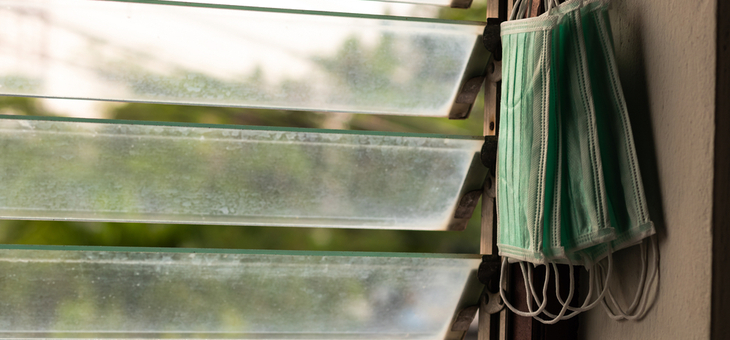New research concludes that ventilation systems in many buildings may increase the risk of exposure to the coronavirus.
Science Daily reports that University of Cambridge researchers found widely used ‘mixing ventilation’ systems, designed to keep conditions uniform in all parts of a room, disperse airborne contaminants evenly.
“These contaminants may include droplets and aerosols, potentially containing viruses,” it reports.
“The research has highlighted the importance of good ventilation and mask-wearing in keeping the contaminant concentration to a minimum level and hence mitigating the risk of transmission of SARS-CoV-2, the virus that causes COVID-19.”
Scientific evidence increasingly indicates that coronavirus is mostly transmitted when we cough, sneeze, laugh, talk, or breathe. And indoor transmission is far more common than outdoor transmission, probably because when indoors we are exposed to dangerous droplets for longer and it takes longer for them to disperse.
Shelly Miller, professor of mechanical engineering at the University of Colorado, says masks do a decent job of limiting virus spread, but if an infected person is inside a building it is inevitable some virus will escape into the air.
“Once the virus escapes into the air inside a building, you have two options: bring in fresh air from outside or remove the virus from the air inside the building,” she says.
“Simply put, the more fresh outside air inside a building, the better. Bringing in this air dilutes any contaminant in a building, whether a virus or a something else, and reduces the exposure of anyone inside,” Prof. Miller says.
“Keeping windows and doors open is a good start. Putting a box fan in a window blowing out can greatly increase air exchange too. In buildings that don’t have operable windows, you can change the mechanical ventilation system to increase how much air it is pumping. But in any room, the more people inside, the faster the air should be replaced.”
Prof. Miller says a $100 carbon dioxide meter can measure if a room is filling up with potentially infectious exhalations.
“The CO2 level lets you estimate if enough fresh outside air is getting in.”
If the room cannot get enough outside air in, she recommends the use of an air purifier.
“These machines remove particles from the air, usually using a filter made of tightly woven fibres. They can capture particles containing bacteria and viruses, and can help reduce disease transmission.”
Zeynep Tufekci, writing in The Atlantic, points out that inadequate air-conditioning can exacerbate transmission risks. She cites a cluster arising from a restaurant in Guangzhou, China, where an asymptomatic COVID-19 patient infected nine other people. Many were sitting at other tables but were in the direct line of the air-conditioner.
“Tables right next to the patient’s but not downwind did not have a single infected person, and closed-circuit camera videos from the day show that the people at the infected tables didn’t interact with the patient at all. It was the air.”
She concludes that most super-spreader events occur at poorly ventilated indoor venues, where a lot of people are talking, chanting, or singing.
Safe Work Australia warns of another danger for buildings reopening after a COVID-19 shutdown.
“Restarting heating, ventilation and air-conditioning (HVAC) systems can carry significant risks to the health and safety of workers and other people who enter the building, if they have not been maintained and inspected in accordance with relevant regulations and standards prior to restarting.”
If cooling towers and condenser water systems have not been chemically treated, there is a risk of Legionnaire’s disease, an often fatal lung infection.
The Cambridge study, by its Department of Applied Mathematics and Theoretical Physics (DAMTP), showed that airflow in rooms is complex and depends on the placement of vents, windows and doors, and flows created by the heat emitted by people and equipment.
‘Displacement ventilation’ extracts warm air through the top part of the room. If properly configured, it can extract contaminated air.
In newer, more airtight buildings, safe ventilation is a big challenge.
“Maximising ventilation, while at the same time keeping temperatures at a comfortable level without excessive energy consumption is a difficult balance to strike,” said Cambridge’s Dr Rajesh Bhagat.
The Cambridge results show that room flows change dramatically, affected by the movement of people, the type of ventilation, the opening and closing of doors and changes in outdoor conditions.
The researchers found that masks are effective at reducing the spread of exhaled breath, and therefore droplets.
“One thing we could clearly see is that one of the ways that masks work is by stopping the breath’s momentum,” said study lead Professor Paul Linden.
“While pretty much all masks will have a certain amount of leakage through the top and sides, it doesn’t matter that much, because slowing the momentum of any exhaled contaminants reduces the chance of any direct exchange of aerosols and droplets as the breath remains in the body’s thermal plume and is carried upwards towards the ceiling. Additionally, masks stop larger droplets, and a three-layered mask decreases the amount of those contaminants that are recirculated through the room by ventilation.”
They concluded that laughing creates a “large disturbance”; if an infected person without a mask laughs indoors, it greatly increases the risk of transmission.
“Keep windows open and wear a mask appears to be the best advice,” said Prof. Linden.
And Prof. Miller’s advice is stark: “If you walk into a building and it feels hot, stuffy and crowded, chances are that there is not enough ventilation. Turn around and leave.”
Do you feel the buildings you have to visit are safe?
If you enjoy our content, don’t keep it to yourself. Share our free eNews with your friends and encourage them to sign up.
Related articles:
https://www.yourlifechoices.com.au/health/covid19/why-your-face-mask-is-your-best-friend
https://www.yourlifechoices.com.au/health/covid19/disturbing-virus-find
https://www.yourlifechoices.com.au/travel/news/restaurants-are-getting-creative

